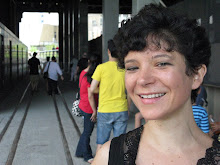This week the lovely Teva Bjerken and I assisted the fabulous Bill Connington at the Jewish Community Center in Manhattan where Bill leads a ten-week course on the Alexander Technique to people with Parkinson’s. Subsidized by NYU’s Parkinson and Movement Disorder Center, this program is that rare phenomenon where neuroscience and various healing modalities come together to help a community in need. This endeavor certainly reflects positive changes in health CARE and is a rich reminder to never give up thirty seconds before the miracle. In addition to Alexander classes, other practices such as yoga, Pilates and Nia are also being offered. That neuroscience is examining the profound effects such routines offer to those who are ill is beyond exciting. VIVE LA REVOLUCION!
So. Alexander and Parkinson’s. What’s the relationship here? In a nutshell, Parkinson’s robs a person of his or her neurological reality, Alexander restores it. But how exactly? Well, that’s what this whole research business is about so the answer is still in the works, but here are some observations from the Field at Large, or my two cents if you will. The touch of a teacher’s hands is key. This specific technique offers remarkable results because it is a learning brought about through touch. This hands-on technique, the specificity of the teacher’s touch, offers physical and emotional support as well as a holistic (psycho-physical-emotional) sensorial re-education like nobody’s business. Shazzam. Oh…and it feels yummy too. It’s gentle, restorative and empowering. To understand the proper coordination of head-neck-back-limbs is profound and practical all at once. And it can be learned. We can understand what that's about. By learning how to undo muscular tension that is causing harm, people gain insight into how to take better care of the Self and leave lessons with a greater understanding of what to do and what not to do (more importantly) in order to feel better. That’s profound on any day of the year but never more so than when struggling with a degenerative illness. So…with firm touch and verbal instruction, a teacher coaxes a person to slow down and find better coordinative patterns that bring about greater postural strength, greater muscle elasticity and tone (providing better coordination of breath) and the return of certain motor skills. An empowering hour was had by all. For a few minutes a day, they are back in the driver’s seat…breathing and moving in a poised and confident manner. What could be more exciting and heartwarming than that? Not much.
Comments from Students with Parkinson’s.
“I didn’t know I could do this [stand and breathe].”
“I feel so much better. I have so much more energy than I did before class!”
“Your hands helped me slow down and notice my feet…I don’t remember to do that often.”
"When you touched my left knee, the tremoring in my right knee went away and I immediately felt calmer."
“I don’t need to press down on myself while I am sitting. I can use the back of the chair to let my spine go up.”
Eureka!! I'm in Alexander heaven, people.... Alexander Heaven. If you have a relative, or know of anyone struggling with Parkinson’s who might want to check out this work, this is an ideal place to explore it. Since it is subsidized, the cost is minimal to the student ($5 a class or something). Information can be found on the JCC website, http://www.jccmanhattan.org. Phone number: 646.505.5700. Once on the site, click under health club and follow to cancer and parkinson’s fitness programs to see the schedule of classes.
Until next time...hope you're all having a sweet sort of day. It's your day after all. So why not take just a sec and notice where you are in space? Are you pulling up? Falling down? Squeezing, holding and making yourself tense all around?
You have brains in your head.
You have feet in your shoes.
You can steer yourself in any direction you choose.
You're on your own.
And you know what you know.
You are the guy who'll decide where to go. ~
- Dr. Seuss
Happy days,
wendy
Friday, May 20, 2011
Subscribe to:
Comments (Atom)
